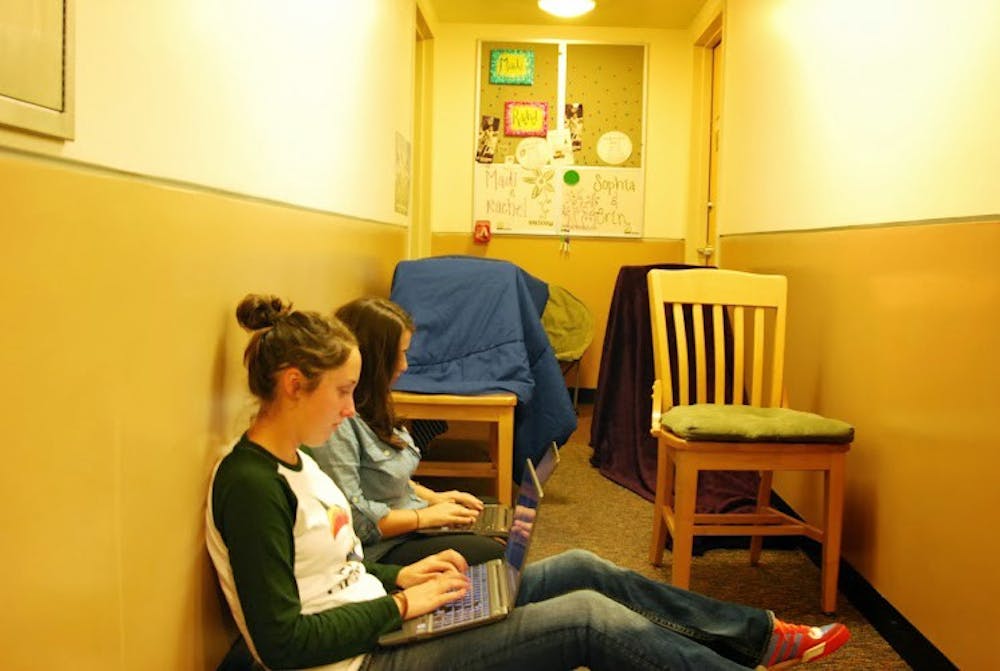By Lydia Laythe |
Sophomore Dominic Lazzaro knows the stress that bad WiFi and cell phone coverage can cause.
“(One day) I was just palling around and playing video games when all of a sudden my phone just had like 10 notifications go off at one second,” Lazzaro said. “Just like ‘boom, boom, boom, boom, boom.’ And I’m like what the heck. (I got) four missed calls, two voicemails, and eight texts. It was my entire squad trying to contact me for ROTC. They were all like ‘Check your email or call us back,’ so I check my email and of course I have no Internet. I try calling them back and I have no service. And I was like, ‘Oh now this is just great.’”
Lazzaro searched for service all around his residence hall and then outside, without any luck. It wasn’t until he was running back to his dorm that he received more notifications and was able to call his squad-mates.
“It was just for some volunteering event, so it wasn’t even a big deal,” Lazzaro said. “But I didn’t know that based on the messages. Not having Internet turned into a nice 15-minute extravaganza trying to find Internet … which was fantastic.”
UP isn’t the only school experiencing issues with Wi-Fi connections. According to a 2013 study by the EDUCAUSE Center for Applied Research, college students will have three to four internet-capable devices with them on campus this semester.
This increase in wireless devices is the number one IT issue facing higher institutions in 2013, according to the Educause IT Issues Panel. Information Services (IS) teams at colleges and universities everywhere are dealing with Wi-Fi connectivity issues as a result.
Michelle Sunderland, director of Technical Services, is working to improve Wi-Fi as well as cell phone coverage on campus.
“It’s a necessity these days to have cell phone coverage and Wi-Fi,” Sunderland said. “It’s not a luxury.”
Junior Katharina Cochran, RA in Corrado Hall, has to stand outside Corrado to make calls.
“I’ll be able to answer the call (in my room) but not actually be able to talk to them,” Cochran said. “I’ll be like ‘Hey,’ and then it’ll just go away. And I have to call them back and be like, ‘Yeah, sorry about my room.’”
Sunderland said residence halls are especially problematic due to the structure of the buildings and the heavy materials, like cement, that they’re made of.
The IS department recognizes the problems on campus are two-fold. The first problem is students don’t have cell phone coverage.
IS is addressing this by meeting with service providers, such as AT&T and Verizon Wireless, and trying to find providers that will invest in the UP community and increase the cell phone coverage.
The second problem is students can’t connect to Wi-Fi. IS is addressing this by assessing, improving and adding Wi-Fi access points across campus. According to Sunderland, there are about 400 Wi-Fi access points on campus and each access point can accommodate around thirty devices.
With the increasing number of devices each person is using on campus, students are maxing out the access points’ abilities to provide coverage.
In response, Sunderland is researching problem areas and looking to add or improve existing Wi-Fi access points across campus.
Curt Pederson, Chief Information Officer, said improving the access points is a gradual process.
“We’re going building by building, floor by floor making improvements,” Pederson said. “It’s more complex than it sounds, but we’re working through it.”
Sunderland’s team of student workers spent the summer creating a map of the Wi-Fi coverage in dorms, so that problem areas could be more easily identified.
“We can look at our research map and say ‘Oh hey, look. We need to fix this little area here,’” Sunderland said.
The IS department recently hired consultants to help them identify where and how to improve bandwidth and coverage, and they predict to have some feedback to work with in a few months.
Beyond basic research and improvements, Sunderland said feedback was a major factor in the work the IS department can do. Student workers in the IS department recently sent out questionnaires to the RCCs and hall residents asking them to identify problem areas so that the IS department can better serve their needs.
“Feedback is the most important,” Sunderland said.
Pederson said he wants to help the students, but change takes time.
“We do care a lot,” Pederson said. “We know the frustration. How do we make sure that everybody gets an equal improvement? It needs to be done in a planned, methodical, funded way. And we have some funds set aside. It just takes time.”
New from the IT Department
Right Now
FrontDoorSoftware for laptops if they are stolen
Google Docs for easy student collaboration
In the Future
Lynda.com for comprehensive tutorials on technology, business, and more
Mobile Applications
Better cell phone and Wi-Fi coverage on campus
If there are any questions about these additions or other technology questions, go to the IT Help Desk in the basement of Buckley Center.








